
A globular cluster is a spherical collection of stars that orbits a galactic core. Globular clusters are very tightly bound by gravity, which gives them their spherical shapes, and relatively high stellar densities toward their centers. The name of this category of star cluster is derived from the Latin, globulus—a small sphere. Occasionally, a globular cluster is known simply as a globular.

Star clusters are very large groups of stars. Two types of star clusters can be distinguished: globular clusters are tight groups of hundreds to millions of old stars which are gravitationally bound, while open clusters, more loosely clustered groups of stars, generally contain fewer than a few hundred members, and are often very young. Open clusters become disrupted over time by the gravitational influence of giant molecular clouds as they move through the galaxy, but cluster members will continue to move in broadly the same direction through space even though they are no longer gravitationally bound; they are then known as a stellar association, sometimes also referred to as a moving group.

The Virgo Cluster is a cluster of galaxies whose center is 53.8 ± 0.3 Mly away in the constellation Virgo. Comprising approximately 1300 member galaxies, the cluster forms the heart of the larger Virgo Supercluster, of which the Local Group is a member. The Local Group actually experiences the mass of the Virgo Supercluster as the Virgocentric flow. It is estimated that the Virgo Cluster's mass is 1.2×1015M☉ out to 8 degrees of the cluster's center or a radius of about 2.2 Mpc.

Hans-Emil Schuster is a German astronomer and a discoverer of minor planets and comets, who retired in October 1991. He worked at Hamburg Observatory at Bergedorf and European Southern Observatory (ESO), and was former acting director of La Silla Observatory. Since 1982, he was married to Rosemarie Schuster née von Holt

Messier 12 or M 12 is a globular cluster in the constellation of Ophiuchus. It was discovered by the French astronomer Charles Messier on May 30, 1764, who described it as a "nebula without stars". In dark conditions this cluster can be faintly seen with a pair of binoculars. Resolving the stellar components requires a telescope with an aperture of 8 in (20 cm) or greater. In a 10 in (25 cm) scope, the granular core shows a diameter of 3′ (arcminutes) surrounded by a 10′ halo of stars.

NGC 3201 is a low galactic latitude globular cluster in the southern constellation of Vela. It has a very low central concentration of stars. This cluster was discovered by James Dunlop on May 28, 1826 and listed it in his 1827 catalogue. He described it as "a pretty large pretty bright round nebula, 4′ or 5′ diameter, very gradually condensed towards the centre, easily resolved into stars; the figure is rather irregular, and the stars are considerably scattered on the south".

NGC 6752 is a globular cluster in the constellation Pavo. It is the third-brightest in the sky, after Omega Centauri and 47 Tucanae, and is best seen from June to October in the Southern Hemisphere.
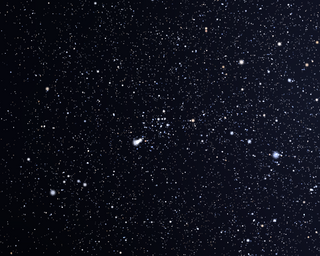
NGC 6204 is an open cluster in the constellation Ara, lying close to the galactic equator. It is 3,540 ly distant from Earth. The cluster was discovered on 13 May 1826 by British astronomer James Dunlop.
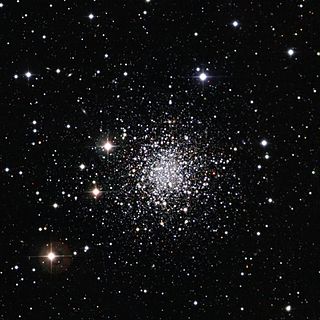
NGC 2257 is a globular cluster that lies on the outskirts of the Large Magellanic Cloud (LMC).

The MPG/ESO telescope is a 2.2-metre f/8.0 (17.6-metre) ground-based telescope at the European Southern Observatory (ESO) in La Silla, Chile. It was built by Zeiss and has been operating since 1984. It was on indefinite loan to the European Southern Observatory from the Max Planck Institute for Astronomy (MPIA). In October 2013 it was returned to the MPIA. Telescope time is shared between MPIA and MPE observing programmes, while the operation and maintenance of the telescope are ESO's responsibility.

Arp-Madore 1 is a globular cluster visible in the constellation Horologium, located 123.3 kiloparsecs away from Earth. It is one of the most distant known globular clusters of the Milky Way galaxy's halo; its distance gives it interest as a test case for gravitational theories. It is named after Halton Arp and Barry F. Madore, who identified it as a distant globular cluster in 1979, using the UK Schmidt Telescope, after previous researchers at the European Southern Observatory had observed its existence but not its classification.

NGC 6362 is a globular cluster in the constellation Ara, lying close to Apus in the southern sky. A telescope with a 150mm primary mirror is required to resolve the stars within this irregularly shaped cluster. The cluster NGC 6362, what's known as a globular cluster, was observed by the Wide Field Imager attached to the MPG/ESO 2.2-meter telescope at ESO's La Silla Observatory in Chile. The resulting photo shows tens of thousands of very ancient stars, along with a good number of stars passing off younger than they actually are. Tightly bound by gravity, globular clusters are composed of old stars, which, are around 10 billion years old, and much older than the sun. These clusters are fairly common. there are more than 150 currently known in our galaxy, the Milky Way, and more which have been spotted in other galaxies. All stars are usually around the same age in a given cluster. Most of the stars inside the cluster are thought to have formed at or around the same time and are thought to be of similar age. Most of the stars inside NGC 6362 are red giants that appear yellow and aged, however, you also see a number of so-called blue stragglers, stars that appear younger than their true age. Blue stars are hot and consume their fuel quickly.

Dark globular cluster is a proposed type of globular star clusters that has an unusually high mass for the number of stars within it. Proposed in 2015 on the basis of observational data, dark globular clusters are believed to be populated by objects with significant dark matter components, such as central massive black holes.

NGC 1783 is a globular cluster within the Dorado constellation and part of the Large Magellanic Cloud, a satellite dwarf galaxy of the Milky Way. It is one of the brightest globular clusters in the LMC as viewed from Earth. It was discovered in 1835 by John Herschel. The compiler of the New General Catalogue, John Louis Emil Dreyer, described this cluster as "considerably bright, large, round, very gradually pretty much brighter middle, mottled but not resolved."

NGC 1755 is an open star cluster in the Large Magellanic Cloud in the Dorado constellation, It is about 120 light years across and due to its size could be a globular cluster. It has a diameter of 2.6′ and an apparent magnitude of 9.9. It was discovered by James Dunlop in 1826.
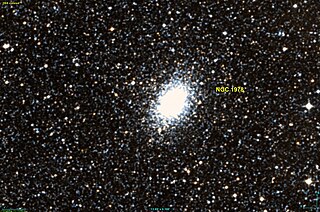
NGC 1978 is an elliptical shaped globular cluster or open cluster in the constellation Dorado constellation. It is located within the Large Magellanic Cloud. It was discovered by James Dunlop on November 6, 1826, and its apparent magnitude is 9.9, and its size is 3.9 arcminutes. Its radial velocity is 293.1 ± 0.9 km/s.
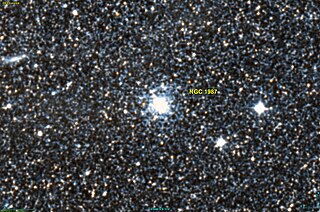
NGC 1987 is an open cluster or a globular cluster located in the Mensa constellation and part of the Large Magellanic Cloud. It was discovered by John Herschel on November 3, 1834. Its apparent magnitude is 12.1, and its size is 1.7 arc minutes. It is thought to be around 600 million years old and has a significant number of red ageing stars.

ESO 444-46 is a giant elliptical galaxy located about 640 million light-years away in the constellation Centaurus. It is the brightest member of the galaxy cluster Abell 3558 which lies in the center of the Shapley Supercluster.
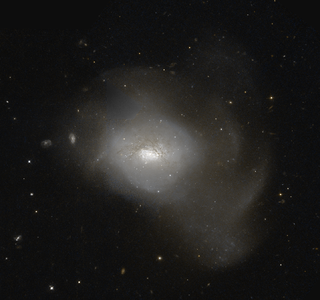
NGC 3597 is a galaxy located approximately 150 million light-years away in the constellation of Crater. It was discovered by John Herschel on March 21, 1835.




















